White Marble. Extraction, how to take care, price
- Hits: 4942
- Extraction of white marble
- Features and advantages of white marble
- What is white marble, where it is quarried and produced
- How white marble is processed
- White marble in interior design
- How to take care of white marble
- Price of white marble in slabs
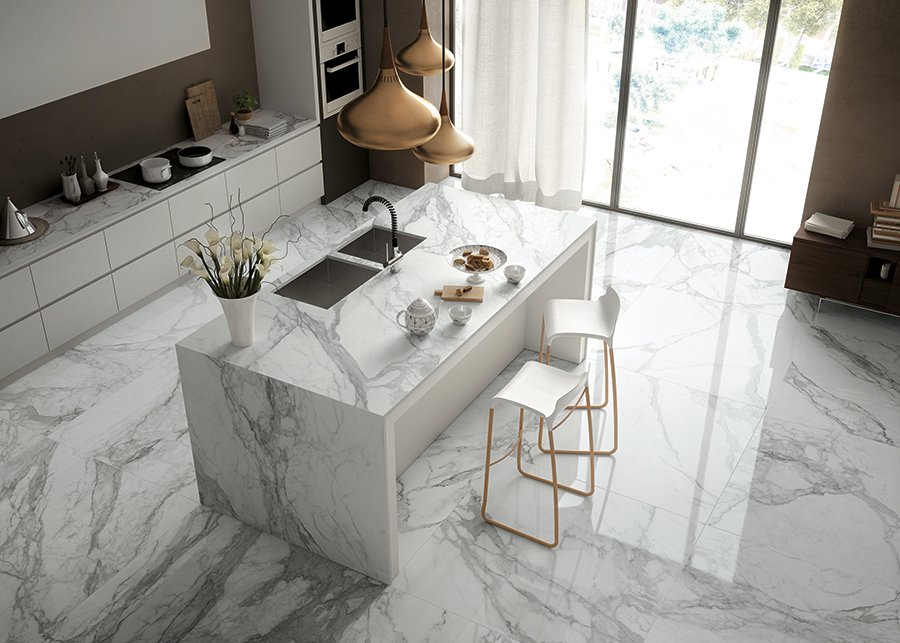
Extraction of white marble
White marble is one of the most common types of marble. White marble is quite common in nature and has been mined since ancient times. The most famous deposits are located in Greece and Italy.
The most valuable of white marble is pure white marble without veins, but it is extremely rare. The most frequently occurring white marble is veined in gray or yellow shades. Marble veins can make up a characteristic pattern, and the color of the marble itself can vary from white to white with a gray tint. There is also a marble with inclusions of pink color. There is also marble with a gold color flecks.
White marble with a gray hue has less commercial value. Stones of high quality have a pure white color without veins or with a yellowish hue.
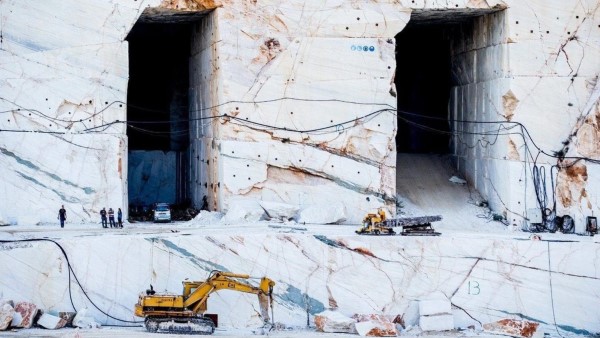


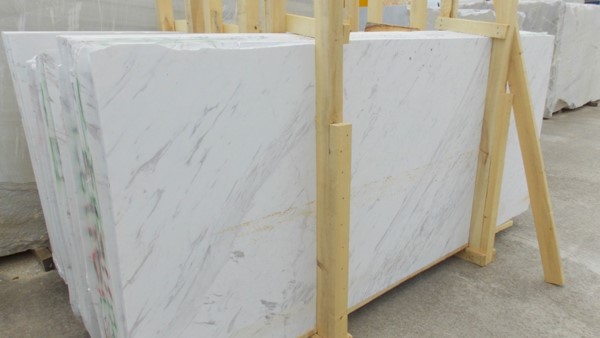
White marble is extracted everywhere. The main deposits of white marble are located in Italy, Greece, Turkey and the United States. These countries are the main suppliers of white marble in the world. Also white marble is mined in India, Mexico, Chile, Southeast Asia.
The Paros marble was mined in the Marpes massif. One of the few marble mined by the shaft method, in closed quarries. Paros marble is coarse-grained, with light yellowish shades, but it is slightly translucent and has a soft velvety sheen. Thanks to this property of semi-reflectivity Paros marble has been used to create many works of art that could not be made from any other material. The mining of Paros marble dates back to ancient times, but later the mines were abandoned and work was resumed with the help of the French only in the 18th century, and from the mid-18th century it was extracted on an industrial scale.
The Pentelikon marble was quarried to the north-east of Athens from Mount Pentelikon, and thanks to its position and proximity to Athens it became famous, as the famous Parthenon temple and many other buildings in Athens were built from Pentelikon marble. The extraction of this marble has been carried out using open-cut methods since ancient times, in the Middle Ages the quarry was abandoned, but in the 19th century the extraction of Pentelikon marble was resumed with the help of the British. The Pentelicon marble is milky white in color that changes with time due to the iron it contains and the ancient pieces are gradually covered with a beautiful golden brown patina under the influence of the atmosphere. Veins of green talc and mica are often found in this marble. When these veins are closely spaced and their layers resemble an onion, this species was called "lapis phrygiens" by the Romans, and "cipolino" in later Italy.
Carrara marble is mined near the town of Carrara, in northwest Italy. Carrara marble is probably the most famous marble in the world, as many famous works of art are made of it. The Carrara marble is divided into varieties: polvaccio, bettogli and crestola. The lower varieties are called "marmo bianco chiaro" of the first and second class and are used mainly for monuments and for architectural works. The dark gray Carrara marble "bardiglio" is also very common. The high price of these three famous statuary marbles allowed their use for artistic and sculptural works, while for architectural decorations they were used only rarely. Somewhat less valuable than pure white marble is marble with light blue veining and of a less pure hue, their value decreases according to the degree of veining and purity.
White marble in New York N. Carolina Florida Maryland Virginia Pennsylvania New Jersey W. Virginia Delaware Ohio
Marble products have always been a symbol of the refined taste of their owner. The formation of marble takes place under the pressure of layers and the influence of the highest temperatures, reaching up to 1000 ° C, marble crystals acquire different shapes and sizes. This is why the texture of marble is so supple and plastic, with subtle transitions of colors. The palette of colors - from pure white to amazing harmonious combinations of blue, green, yellow, red, gray and brown hues. Interiors made with marble are not depending on the tendencies of fashion, they are luxurious and individual.
Peculiarities and advantages
of white marble
The main advantages and characteristics of white marble can be described as follows:
If the stone is a solid rock of high quality, this ensures a long life of the items made of it. It is established that the initial signs of their wear begin to appear after 100 years or more.White marble and other varieties of this rock are very well amenable to processing - in case the marble is strong, malleable and has a certain degree of ductility.
The plasticity and hardness of the material allows for the manufacture of products whose shape is very complex, and when grinding and polishing the stone clearly shows its natural patterns and texture.
White marble has a high degree of water resistance. This allows it to revethe premises with a high level of humidity: bathrooms, swimming pools, baths and fountains.
This rock is so versatile that it is most often used for large finishes and cladding: marble is used to make majestic columns, staircases, wall panels.
Stone is not only environmentally friendly and safe, but also very useful for any room. Thanks to its porous structure it "breathes" and creates a microclimate favorable to human health.
White marble combines perfectly with other materials - wood, other species, metal. It also fits well in different styles and interiors - baroque, traditional and neo-classicism, as well as in modern solutions in the form of minimalism and high-tech.
With all the undoubted advantages, this type of marble is particularly susceptible to weather and climatic influences. Sometimes it stains and has a yellow tint.
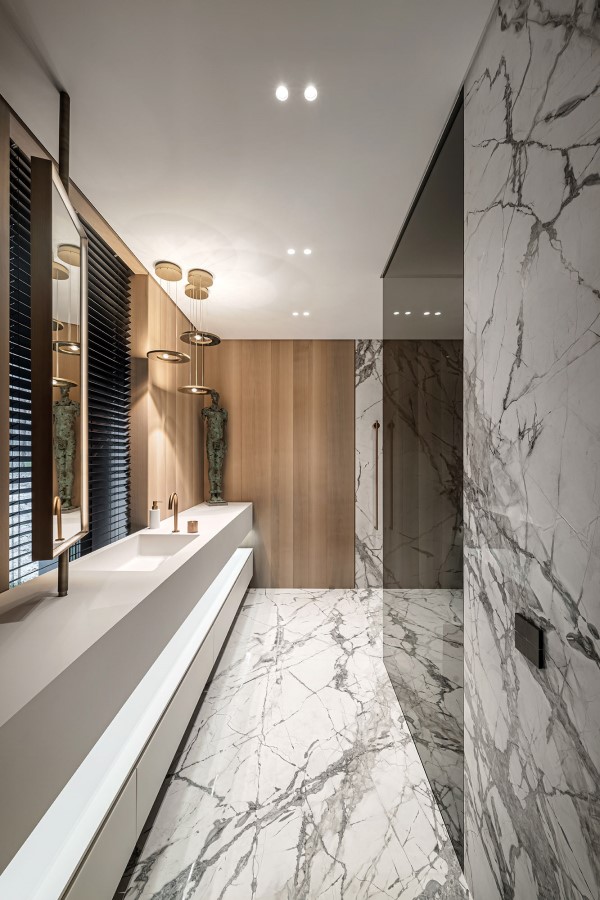
What is the white marble,
where it is extracted and produced
Many people think that white marble comes in only one shade, but this is far from it. The color and its shades are largely influenced by the place where the material was found, as well as other substances (impurities) in the composition of the stone in addition to the main.
The bizarre and surprising patterns are formed thanks to the crystal structure of the stone. It can have a homogeneous structure with veins that are barely noticeable against the general background. The color of the veins is sometimes grayish, which looks especially expressive on a white background. There is also a white or grayish background with many-colored stripes, some yellow or even pinkish.
One of the special varieties of this type of marble is a stone that has a white-beige color. Its background is whitish with a cream tint, while the specks, spots and veins are beige without clear borders. The white-beige kind of marble is mined in Namibia, and in very large quantities. However, the world market does not abound in it, and for this reason it is so expensive and rare.
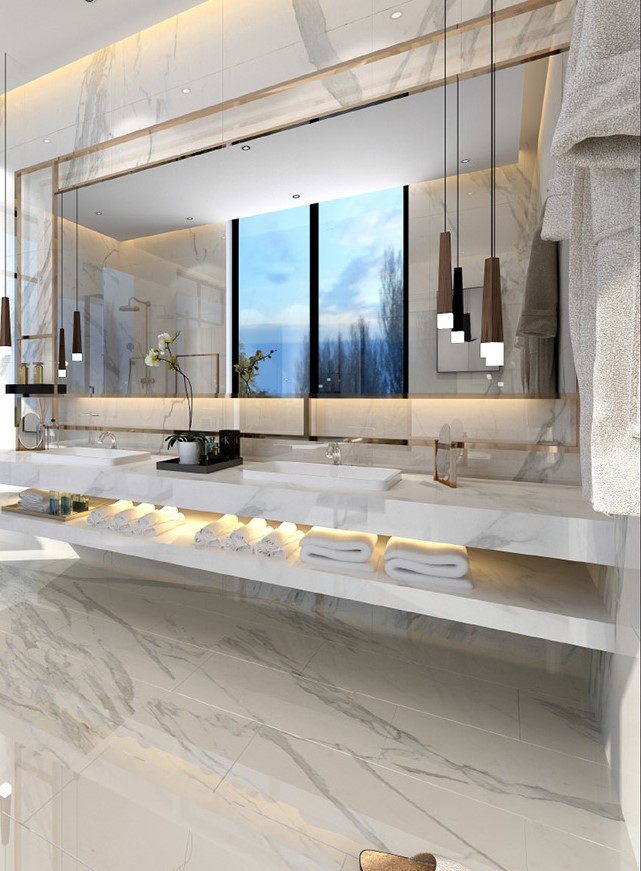
How white marble is processed
For processing white marble, cutters of different sizes, marble drills and saws are used. There is no need to fear that it will collapse: its strength is ensured by its fine homogeneous structure. It is thanks to this that such an art as fine carving of marble became possible. The combination of durability, suppleness and the unique color with its various shades have made this material a favorite among sculptors and craftsmen.
The surface of the material is usually polished to its characteristic luster, but fine sanding is the preferred type of finish. The material, which has a uniform white color, contains a minimal amount of impurities, so it is most often used for the manufacture of sculptures.
"Capriciousness" of white marble, unfortunately, is also caused by its delicate color and finely dispersed, prone to yellowing, structure. Cold weather he takes it well, but later may appear color changes, which is difficult to remove from the surface. In spite of these disadvantages, the stone has no competitors: it still holds a mark of perfection among other facing and sculpture materials.

White marble in interior design
Our catalog presents textures of a wide range of natural marble, which will allow you to create an exquisite interior in accordance with the architectural concept of the design projects of any complexity. Marble tiles and slabs are actively used for finishing floors, walls, stairs, window sills, decorative niches and even ceilings. A marble tabletop will be a luxurious element of your kitchen or bathroom, giving it a spirit of aristocracy. Each marble slab has a unique and one-of-a-kind pattern, whose pristine beauty is preserved for many years. On our site it is convenient to choose and inexpensive to buy a marble of fantastic beauty for a stylish decoration of your interior.
There are basic rules, established by professionals, which will help to use marble competently and with maximum taste:
If this stone is used in the interior, it should not be too much.
Since white visually increases any space, in small rooms its use is especially recommended.
As for the items of cladding, it is better to stop at the classics, not carried away by ornate patterns.
Floor and walls are finished with marble not so often, because it is very expensive. Most often, natural stone is used for partial wall decoration, or especially emphasize their most important part of the zoning rooms. The white marble tile, laid on the floor, will get dirty very quickly and lose its original luster.
If a person has the opportunity, experts recommend decorating bathrooms with white marble: here white marble will look natural and harmonious.
Marble stairs have long been a kind of "living" legend. Long since they testified about the solvency of the owner and about his fine taste. It is clear that the cost of such material, including work, will not be cheap. But if we compare the installation technology with work on the installation of, for example, a wooden staircase - such a marble staircase will cost almost the same amount. In addition, compared to natural wood, marble is much more durable and hard-wearing material. Such a staircase will never irritate its owner creaking, it will not get bugs, and it will not rot after a certain number of years.
If there is a serious intention to establish a marble staircase in a house or other premises, it is important to keep in mind that fine-grained varieties of stone are most suitable for its manufacture - they are elastic and durable. In addition, marble weighs a lot, which requires a staircase is especially strong and secure foundation.
Window sills made of white marble bring a whole new note to the interior of the room. It becomes chic, solemn and original. Such a window sill will fit perfectly in a large room, and even in a small kitchen, given the variety of shapes and sizes of products. As for the marble fireplaces, long ago their presence in the house meant sophistication and comfort, and the unique pattern of stone gives each of them their own unique beauty.
As the work on marble have their own features and subtleties, many of which are known only to professionals, it is best to entrust the installation of stairs, fireplaces and other interior elements to experienced craftsmen.

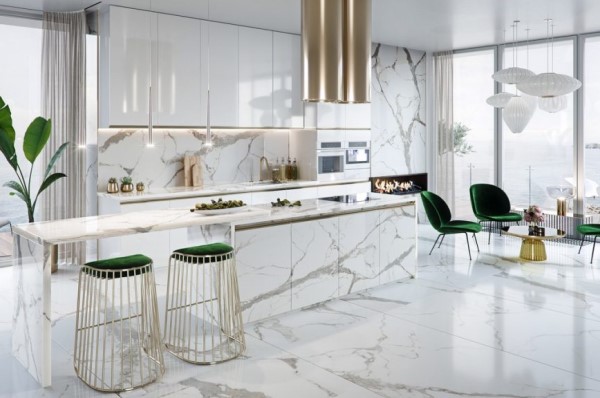

How to take care of white marble
Over time, stains and smudges can appear on white marble. The color may also change. This depends on the initial quality of the material and whether there have been any irregularities in the installation techniques of the stone.
Frequent reasons for the deterioration of the appearance of marble can be summarized as follows:
- The seams and joints are insufficiently waterproofed;
- The glue used for marble turned out to be of poor quality;
- At laying were committed technical errors.
If you take care of the marble correctly, it will ensure the maximum preservation of its original appearance for a long time. If you regularly apply a protective coating of natural wax on the surface, it will repel particles of dust and dirt from the stone. Damp cleaning in the room with marble products should be carried out regularly, and dirt should be removed with the help of compositions designed for the care of stones of natural origin. Do not clean white marble usual abrasives in the form of powders, it is important to ensure that the composition of any means was no acids.
If the room has marble windowsills and tables, you should not allow liquids to spill on them. If this does happen, the liquid must immediately be removed with a dry cloth, and the surface should be treated with a special stone cleaner. To remove grease stains, the use of white spirit is acceptable. A doormat in the hallway will also not be superfluous: it will protect from street dirt and sand.
White marble is a wonderful natural stone. Products made of it will never go out of fashion and will always fascinate people of different ages and generations with their magnificence - because of pristine natural beauty and uniqueness of the natural stone texture. The right care and careful handling will ensure maximum longevity of marble products, many of which are rightly called real works of art.

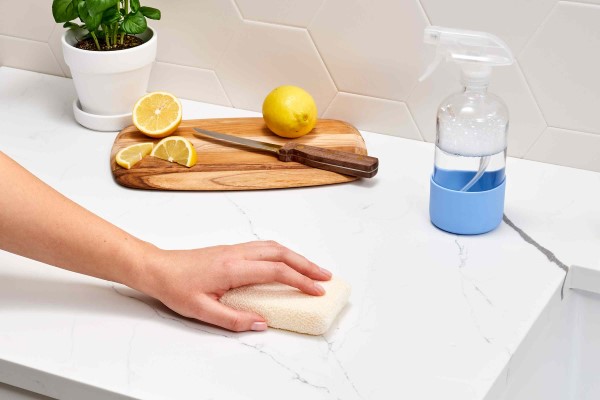
Price of white marble in slabs
The price of white marble varies. It depends on many factors. This remoteness of a deposit, extraction volume, complexity of extraction, complexity of transportation of material from the deposit to the client, format - standard slab or block with a price per m3. The closer the deposit, the easier it is to bring the rock, the larger and simpler its extraction, the lower will be the price of white marble.
Contact Info

Phone
E-mails
MD: This email address is being protected from spambots. You need JavaScript enabled to view it.
FL: This email address is being protected from spambots. You need JavaScript enabled to view it.
NJ: This email address is being protected from spambots. You need JavaScript enabled to view it.

